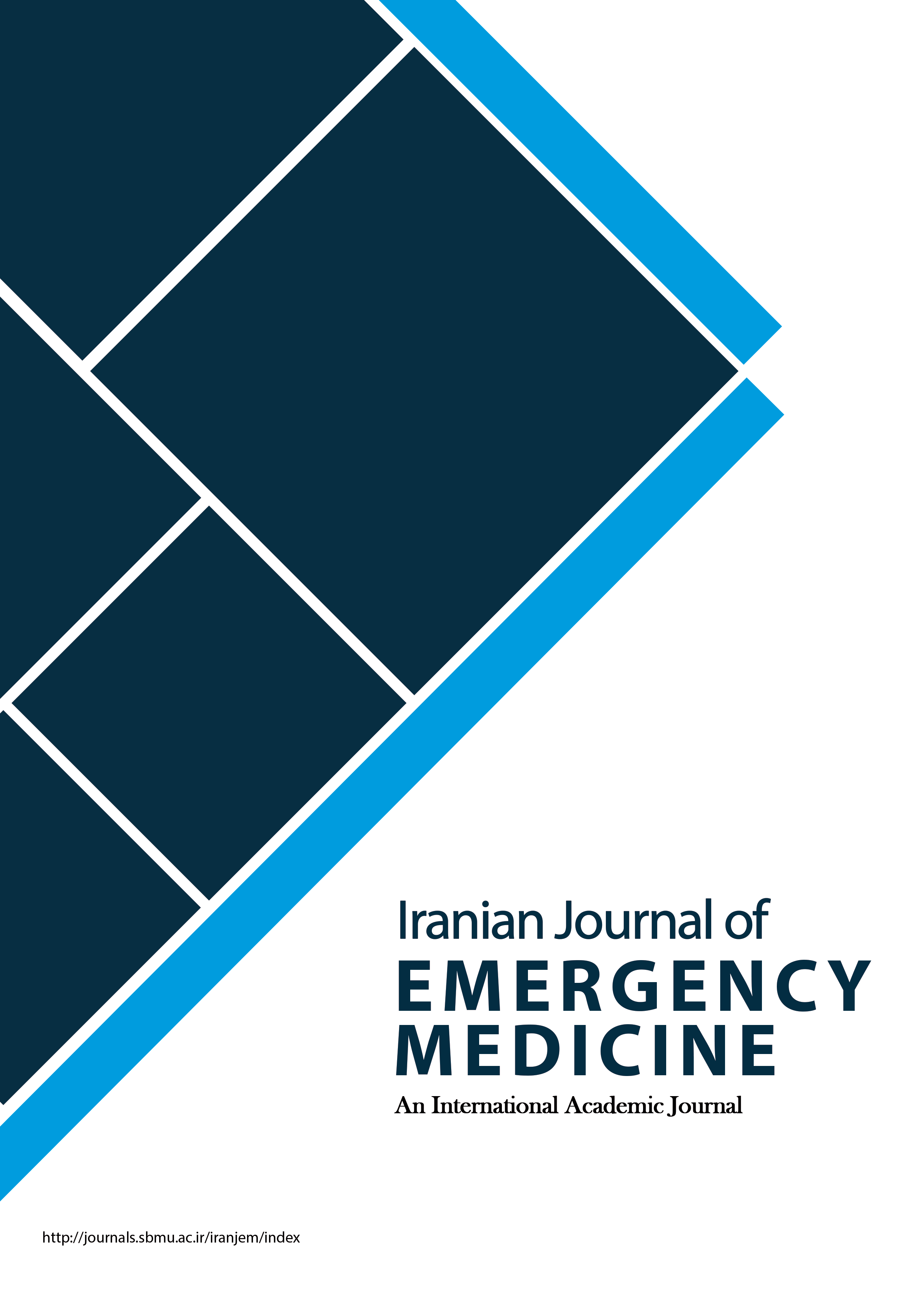Effect of Length of Stay in the Emergency Department on Hospital Outcome of Critically ill Patients: a Descriptive-Analytical Study
Iranian Journal of Emergency Medicine,
Vol. 8 No. 1 (2021),
23 November 2020
,
Page e8
https://doi.org/10.22037/ijem.v8i1.33259
Abstract
Introduction: Emergency department is one of the most important departments in a hospital, the performance of which has a great impact on the functionality of other departments and patient satisfaction. The aim of this study was to determine the effect of the emergency department length of stay (EDLOS) of critically ill patients on their hospital outcome.
Methods: In a descriptive-analytical study, 450 critically ill patients who referred to the emergency department of Sina and Imam Reza (AS) Hospitals affiliated to Tabriz University of Medical Sciences in the period between November 2019-September 2020 were enrolled. The EDLOS was registered based on the time taken to leave the emergency department. The patients were followed until their final discharge from hospital and their final outcome was recorded. Data were collected and analyzed using SPSS version 17. The final outcome of the patients was compared based on their EDLOS.
Results: In this study, 450 critically ill patients were included. The median of their EDLOS was 3 hours and their median duration of hospitalization was 6 days. Among the studied patients, 100 patients (22.22%) died. There was no statistically significant relationship between patients' mortality and EDLOS (P˂0.05).
Conclusion: Based on the results, there was no statistically significant relationship between EDLOS and hospital outcome of critically ill patients. Therefore, it can be concluded that either the time of discharge from the emergency department has been appropriate or the treatment measures required by critically ill patients have been provided in the emergency department with the same quality as special wards.
- Emergency ward
- Outcome
- Mortality
- Triage
- Critically Ilness
How to Cite
References
Jadidi A, Zand S, Khosravi M, Harorani M, Bayati A, Amni T, et al. Evaluating the Timing of Emergency Department Services in Hospitals of Arak City. Iranian Journal of Emergency medicine. 2017;4(2):62-57.
Arhami Dolatabadi A., Shahrami A., Amini A., Alimohammadi H., Maleki M. Evaluation of Non-emergency Cases Using Emergency Department Services. Iranian Journal of Emergency Medicine. 2017;4(3):91-6.
Nee PA. Critical care in the emergency department: severe sepsis and septic shock. Emerg Med J. 2006;23(9):713-7.
Rahmani F, Ebrahimi Bakhtavar H, Shams Vahdati S, Hosseini M, Mehdizadeh Esfanjani R. Evaluation of MGAP and GAP Trauma Scores to Predict Prognosis of Multiple-trauma Patients. Trauma Monthly. 2017;22(3):-.
Simchen E, Sprung CL, Galai N, Zitser-Gurevich Y, Bar-Lavi Y, Gurman G, et al. Survival of critically ill patients hospitalized in and out of intensive care units under paucity of intensive care unit beds. Critical care medicine. 2004;32(8):1654-61.
Valley TS, Noritomi DT. ICU beds: less is more? Yes. Intensive Care Med. 2020;46(8):1594-6.
Aldawood AS, Alsultan M, Haddad S, Alqahtani SM, Tamim H, Arabi YM. Trauma profile at a tertiary intensive care unit in Saudi Arabia. Annals of Saudi medicine. 2012;32(5):498-501.
Rahmani F, Rezazadeh F, Ala A, Soleimanpour M, Mehdizadeh Esfanjani R, Soleimanpour H. Evaluation of Overcrowding of Emergency Department in Imam Reza Hospital in 2015 by Implementing 2 Scales: NEDOCS and EDWIN. Iran Red Crescent Med J. 2017;19(6):e15609.
Chalfin DB, Trzeciak S, Likourezos A, Baumann BM, Dellinger RP. Impact of delayed transfer of critically ill patients from the emergency department to the intensive care unit. Critical care medicine. 2007;35(6):1477-83.
Cardoso LT, Grion CM, Matsuo T, Anami EH, Kauss IA, Seko L, et al. Impact of delayed admission to intensive care units on mortality of critically ill patients: a cohort study. Critical care (London, England). 2011;15(1):R28.
Rivers E, Nguyen B, Havstad S, Ressler J, Muzzin A, Knoblich B, et al. Early goal-directed therapy in the treatment of severe sepsis and septic shock. The New England journal of medicine. 2001;345(19):1368-77.
Albers GW, Amarenco P, Easton JD, Sacco RL, Teal P. Antithrombotic and thrombolytic therapy for ischemic stroke: the Seventh ACCP Conference on Antithrombotic and Thrombolytic Therapy. Chest. 2004;126(3 Suppl):483s-512s.
Gordon JA, Billings J, Asplin BR, Rhodes KV. Safety net research in emergency medicine: proceedings of the Academic Emergency Medicine Consensus Conference on "The Unraveling Safety Net". Academic emergency medicine : official journal of the Society for Academic Emergency Medicine. 2001;8(11):1024-9.
Al-Qahtani S, Alsultan A, Haddad S, Alsaawi A, Alshehri M, Alsolamy S, et al. The association of duration of boarding in the emergency room and the outcome of patients admitted to the intensive care unit. BMC emergency medicine. 2017;17(1):34.
Farahmand S, Karimialavijeh E, Vahedi HSM, Jahanshir A. Emergency medicine as a growing career in Iran: an Internet-based survey. World J Emerg Med. 2016;7(3):196-202.
Chong CP, Haywood C, Barker A, Lim WK. Is Emergency Department length of stay associated with inpatient mortality? Australasian journal on ageing. 2013;32(2):122-4.
Singer AJ, Thode HC, Jr., Viccellio P, Pines JM. The association between length of emergency department boarding and mortality. Academic emergency medicine : official journal of the Society for Academic Emergency Medicine. 2011;18(12):1324-9.
Liew D, Liew D, Kennedy MP. Emergency department length of stay independently predicts excess inpatient length of stay. The Medical journal of Australia. 2003;179(10):524-6.
Zhang Z, Bokhari F, Guo Y, Goyal H. Prolonged length of stay in the emergency department and increased risk of hospital mortality in patients with sepsis requiring ICU admission. Emerg Med J. 2019;36(2):82-7.
Rose L, Scales DC, Atzema C, Burns KE, Gray S, Doing C, et al. Emergency Department Length of Stay for Critical Care Admissions. A Population-based Study. Annals of the American Thoracic Society. 2016;13(8):1324-32.
- Abstract Viewed: 366 times
- pdf (فارسی) Downloaded: 201 times



